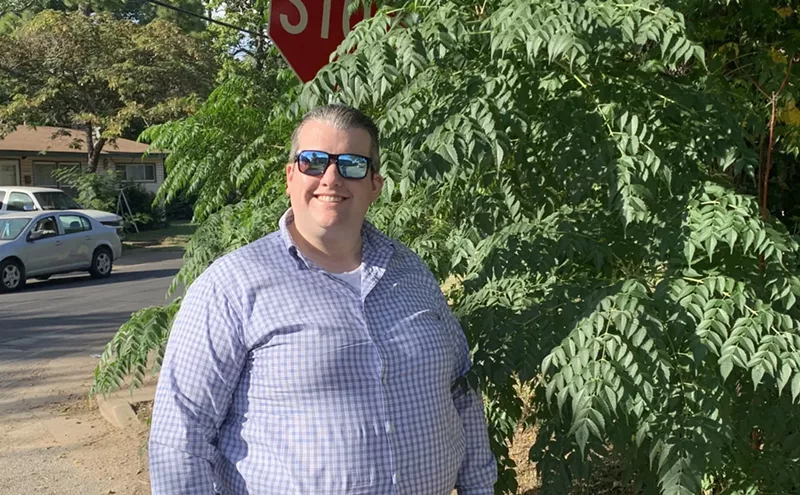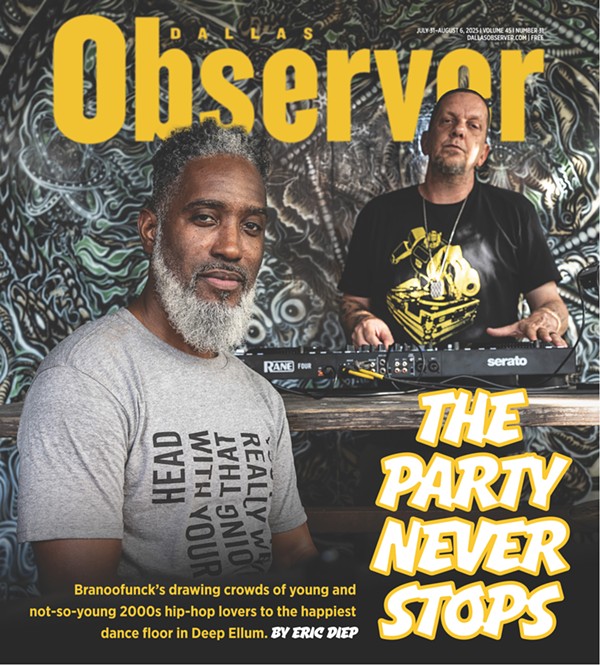He paces the halls, careful not to wake his mother, who is sleeping downstairs. It's a big house--3,000 square feet--but sometimes she hears him stirring, playing his guitar, watching TV or writing in his online journal. Anything to keep his mind off the "nonstop itching/biting/crawling" sensation under his skin.
In many ways, he's a normal 22-year-old, albeit a bit troubled. He is of average height and build, with the pale skin of someone who spends most of his time in front of a computer. He's struggled with drug addiction, loneliness and depression, and he and his mom have had their issues, although things are better now. He's taking classes at the community college in Austin where his mom works as a software engineer, and he's made some friends there. Maybe he'll move out soon.
If only he could get better. He's always been sickly, even as a boy growing up in Washington state, but this is unlike anything he and his mom have seen before. The itching isn't even the worst of it. He has lesions all over his thin, frail body, on his legs, his arms, the back of his neck. His sweat is black, thick as tar. Something is terribly wrong with him.
He knows what it is, even if most doctors don't acknowledge it as a real disease. It's called Morgellons. He discovered it on the Internet in January 2005. All over the country, but especially in Texas, Florida and California, people are diagnosing themselves. They are ranchers and lawyers and bartenders, people from all walks of life, in cities big and small. And they have the same symptoms--the itching, the lesions, the fibers.
Yes, the fibers. That's really the worst part. Fibers sprouting from his skin. Thin, like fishing wire, sometimes blue or red, growing from his body. One night he looked down and, to his horror, saw a spaghetti-like strand sticking out of his chest. He called out to his mom, who found a pair of tweezers and tried to pull it out, but the fiber sunk back, like it had a mind of its own.
He figures he caught the disease in Mexico, perhaps from drinking the water. Or maybe he caught it because he has Lyme disease, like his mother. There are all kinds of theories on the Internet: Maybe it came from "chemtrails"--the exhaust plumes from jet planes--or chiggers or a government conspiracy. He doesn't know what to believe. He has a disease with no known cause and, worse, no known cure. Beyond the bizarre physical symptoms, it makes him weak and forgetful. His left hand sometimes trembles, he loses his sense of smell, he goes days without sleeping or eating.
Morgellons, a disease that may not even be real, is slowly killing him. And although he doesn't know it yet, he will become its public face.
Before 2002, nobody had heard of Morgellons disease. Today, there are more than 4,000 people in the United States who say they have it, and hundreds more worldwide. Doctors who believe the disease is real, and there are at least a dozen, have no idea what causes it. As Wilson discovered, the theories range from the plausible (bugs) to the outlandish (French bottled water). Whatever its cause, those who have seen the disease up close say it is horrifying, like something out of a sci-fi movie.
"It's unlike anything we've seen to this point," says Ginger Savely, a San Francisco nurse practitioner who has treated more than 125 Morgellons patients, most of them from Texas. "It's so different that it sounds kind of...well, it's scary because it's so different. Some of the things I've seen, it could really make you doubt your own sanity." Wilson's symptoms, for example--lesions, black sweat, colored fibers sprouting from the skin--are some of the most commonly described symptoms. Other side effects include hair loss, "brain fog," crippling fatigue and, occasionally, the disintegration of teeth.
Two of the largest clusters of the disease, according to the Morgellons Research Foundation, are in the Houston and Dallas areas. Judy Egan, a 55-year-old bar manager who lives near Arlington, says she and her husband contracted Morgellons about a year ago after handling produce at a farmers market near Mansfield. Both have seen strange fibers coming out of their skin. Others who have the illness are afraid to speak publicly about it, fearing friends and co-workers will think they're nuts.
"If somebody would have told me about this two and a half years ago I would have thought, well, too much LSD for you," says an Allen middle school teacher who didn't want to be identified. "You know, this doesn't sound like anything from our world. It's so out there."
Mainstream medicine dismisses the disease as imaginary, and most Morgellons sufferers have been diagnosed with delusional parasitosis, a psychiatric condition in which patients believe they are infested with parasites. Psychiatrists have noted that patients with this disorder will sometimes dig out small fibers--which are most likely peripheral nerve endings--to prove that bugs are in fact crawling under their skin. Other doctors suspect the fibers are actually from clothing, carpet or upholstery.
"It's probably just a variant of delusions of parasitosis," says Dr. Dan Eisen, a University of California at Davis dermatologist. "It's fairly common. Most dermatologists have seen people who complain that they have bugs crawling under their skin. This sounds like the same thing, except they're not complaining of bugs, they're complaining of fibers."
Doctors such as Eisen also say it's unlikely that the varied symptoms associated with Morgellons--from lesions to joint pain to loss of vision--could all be caused by the same disease. What's more likely is that as word of Morgellons spreads through the Internet and television news coverage, more people become convinced they have it. If this is the case, then Morgellons is one in a long line of weird diseases that have swept through populations, only to disappear without a trace once public concern subsides.
Related
Until recently, public health officials more or less ignored Morgellons. Now, after more than a year of fielding complaints and inquiries from around the country, the Centers for Disease Control is forming a task force to investigate. What they will find is anybody's guess. Perhaps Morgellons is an imaginary disease. Or perhaps, as some doctors have suggested, it is the scariest thing ever to hit America.
The story of Morgellons disease begins in the summer of 2001 in suburban Pennsylvania, when, for no explicable reason, a 2-year-old boy comes down with a mysterious rash. Lesions then break out over his entire body, including his lips.
An infectious disease specialist diagnoses him with a rare form of scabies and prescribes an anti-fungal cream. The boy's mother, Mary Leitao, is assured the rash will clear up.
One night while spreading the cream on her son's arms, Leitao notices something coming out of his skin. It looks like balls of fuzz or maybe dead bugs. Even under magnification, she can't tell exactly what she's looking at. Maybe it's scabies excrement, she thinks.
As her son's health deteriorates, Leitao becomes frustrated with her dermatologist, who doesn't know what's wrong with the boy. So Leitao turns to the Internet. On a scabies message board she details her son's condition. "If your son has fibers coming out of his skin, you're in really deep weeds and we're sorry," comes the response. The good news is she isn't alone. There are others who have the same thing, all over the country.
One day while researching an obscure 17th-century medical text, Leitao comes across a disease called Morgellons, defined by "strange hairs" that break out on the backs of children, causing coughing and convulsions. To Leitao this sounds similar to her son's condition. From then on, in conversations and on her Web site, her son's condition is called Morgellons.
Word spreads. Other Web sites and message boards warn of Morgellons, and the theories take off. Perhaps it is caused by chemical spills or bio-terror or even alien abductions. On a radio program called Coast to Coast--popular among people who believe in UFOs and ghosts--a New Mexico doctor reports that a former CIA agent told him the disease was caused by the French. A botched government experiment, he says, contaminated the water. All Evian drinkers are at risk. "I'm of the firm belief that this is the beginning of a worldwide epidemic," the doctor later declares.
The mainstream media take notice. Television stations in Idaho, Alabama and California do stories on Morgellons. A station in San Francisco interviews Billy Koch, a former closer for the Oakland A's who says he has the disease. Doctors start calling. First from Houston, then from Georgia and then from San Francisco. All of them believe the disease is real.
In 2004, Leitao forms the nonprofit Morgellons Research Foundation. Two members of its medical advisory board, Dr. Raphael Stricker and Ginger Savely, have been at the forefront of the "Lyme wars," an ongoing battle over a chronic strain of Lyme, which some doctors say does not exist, and how to treat it. Both have been instrumental in convincing lawmakers that chronic Lyme is a growing threat and that more money should be spent to better understand it.
Despite their best efforts, the Morgellons Research Foundation is unable to drum up the same kind of support. Senator Dianne Feinstein of California writes a letter in their behalf, asking the CDC "what, if any, actions" it has taken regarding the disease. Senator John Cornyn of Texas asks the same of his state health department. In response, Leitao gets encouraging phone calls and letters from public health officials, but they ultimately go nowhere.
Then, in 2005, the Morgellons movement gets a boost. An assistant professor of pharmacology at Oklahoma State University named Randy Wymore, who has built much of his career on studying obscure diseases, wants to research Morgellons. The fact that a professor at a medical school would even consider studying the disease is great news for Leitao. It's exactly what an organization in need of credibility has been waiting for.
At the request of the MRF, patients and doctors begin sending Wymore samples of fibers they have extracted from their skin. The fibers all look very similar, but Wymore is skeptical. So he begins to gather his own samples, from Wal-Mart and carpet stores, from horses, dogs and cats, even from a llama at his daughter's elementary school. Over time he becomes more and more convinced that the fibers people are sending him are unlike anything seen before.
Beginning in early 2006, 14 Morgellons patients come to Wymore's lab on two separate occasions. Six are children and eight are adults. All have fibers that appear to be growing from their skin. To prove that the fibers are not environmental contaminants, Wymore and his staff, which includes a doctor and a pediatrician, cut into the skin and remove colored fibers. "To find fibers underneath unbroken skin where there's no lesion, no scarring, no sign of scratching whatsoever, would preclude any possibility of this being contaminants from the environment," Wymore says.
He sends the fibers to an independent pathology lab in Tulsa. During the testing process the fibers are accidentally drained down a sink. He sent another batch in June and eagerly awaits the results.
Word of Wymore's research spreads. Dermatologists contact him, angry that he is giving this psychiatric disorder credibility. This is nonsense, they tell him.
"I know there are some physicians who consider me part of the lunatic fringe," he says. "But I'm convinced that if they came into my lab and spent a day with me and these patients and saw what I'm seeing, they would believe this is real. I stopped doubting a long time ago."
In the last few months, Wymore has been bombarded by phone calls and e-mails from Morgellons sufferers, family members and co-workers, even school principals who wonder if the disease is contagious. Doctors from all over the country have called, asking him how they should treat the disease. Since May, he has received 486 e-mails asking for some help or information. He wonders why the CDC isn't doing more.
"Why am I the one dealing with these people?" he asks. "I have no problem dealing with people in Oklahoma as a sort of public service aspect of my job, but when it starts coming from New York and California and Washington and Minnesota, I mean, we've crossed state lines--it seems to me this should become a federal issue."
Leitao is also frustrated that the CDC hasn't done more. Besides her youngest son, now 7, Leitao's two teenagers have also contracted Morgellons. All three experience joint pain, lesions, fibers and a loss of energy, and all miss school regularly. "We don't have time to wait for the CDC. We're going to absolutely move forward on our own. We have to," she says. "I have sick kids, and we don't have time to wait. None of us do."
Back in Leander, Travis Wilson is getting worse. Fibers are coming out of his fingers, his neck, even his mouth. He wants to transfer to the University of Texas and major in psychology. Basically, he just wants to help people, he writes in his online journal. "All of my life I've taken and never given back," he writes. "I need to balance my karma." But he is wasting away. He can't eat because the fibers get in his food. When he bathes, black fibers seep out of his skin and ring the tub. He goes to doctors and tells them of the fibers, but they don't see anything. Maybe that's because they talk to him from across the room. Maybe that's because they're convinced he's delusional, without even really looking at him.
"If you want to know about the sci-fi nightmare that is Morgellons disease, then feel free to go to the main site at www.morgellons.com," he writes in his online journal. "Check out the forums to read all the cool things like morphing hairs, cotton white and black pustules popping out of people's skin, and all sorts of neat physical and mental trauma that I've endured over the past eight months."
He finds Ginger Savely, a nurse practitioner on the MRF medical advisory board who has a practice in Austin. Savely sees white fibers growing out of his hand and black specks that look like pepper that come out of his palm. If he brushes them off, they come right back.
But even Savely doubts some of the things he says he's seeing. He points at the air and says, "See--there they are, there they are." Savely doesn't see anything.
His mom is also worried. She assures Travis that no one has hacked into his computer, that bugs are not coming out of the screen. Privately, she worries that he is losing his mind. He sometimes sees black vans parked out in front of their house. Maybe he is the subject of a U.S. government experiment, he thinks.
"Hey kids! From the same people who brought you the Gulf War Syndrome, now present to you Morgellons, a new biological warfare study that our government has launched on our own people!" he writes. "Have fun with it! Just don't go and commit suicide, junior, that'll screw up their neat and tidy data."
He isolates himself, even from his mother, afraid the disease is contagious. They stop eating together, they separate their laundry, they avoid sitting on the same couch. His worst fear is that he will contaminate her. She goes out of town and he tears up the carpet and burns it, along with his clothes and their couch, trying to stop the spread of the disease.
On March 24, he makes what sounds like a final entry in his online journal. "Still alive, sort of," he writes. "Here's a chapter from my novel I'm writing: Goodbye Blue Sky."
He begins with a Smiths song. "Don't try to wake me in the morning, because I will be gone/Don't feel bad for me, I want you to know/Deep within the cell of my heart I will feel so glad to go/There is another world, there is a better world."
Sometimes, it seems suicide is the only escape.
No one disputes the link between mental illness and Morgellons. The question is which comes first. Morgellons sufferers, or Morgies, insist that the horrific symptoms of the disease bring on delusions and obsessive-compulsive behavior. Detractors say it's the other way around.
One of the most popular Web sites on the disease is Morgellons Watch, a blog dedicated to poking holes in every known theory on the disease. The blog operator would only agree to an interview via e-mail and would only identify himself as Michael from Los Angeles. Leitao, the director of the Morgellons Research Foundation, suspects that Michael is a dermatologist. Michael describes his interest in Morgellons as a hobby, nothing more.
"I hate seeing people misled. I'm a skeptic, and this just seemed something that would benefit from investigation," he says. "...I keep anonymous to avoid making enemies."
One of Michael's theories is that Morgellons is a mass psychogenic illness. Other sites popular among skeptics, such as Mind Hacks, have suggested the same thing.
A mass psychogenic illness is an illness in which real physical symptoms are created by the mind. Earlier this year in Portugal, for example, large numbers of schoolchildren came down with symptoms that mirrored those suffered by characters in a popular teenage soap opera. The outbreak came just days after an episode aired about a life-threatening virus descending on a school.
Then there's Koro, or penis panic, in which a man believes his penis is shrinking into his body. Some men with Koro have gone as far as attaching fish hooks to their foreskin. In 1967, a Koro outbreak in Singapore subsided only after a massive propaganda campaign in which health officials assured the public it was anatomically impossible for the penis to retract into the body. The government also ordered the media to stop airing stories on reported cases.
As recently as 2003, a similar epidemic swept through the capital of Sudan, where hundreds of men became convinced their penises would melt if they came into contact with Zionists trying to wipe them out. Word of the disease spread through the media and text messaging. One local columnist advised readers to avoid "a dark-skinned man" who was spreading the disease. Others thought the disease was passed through verbal curses or an electronic "robot" comb.
Similar mass outbreaks have occurred in the United States. In the summer of 2002, the New York Times Magazine ran a story about a mysterious skin rash that appeared at more than two dozen elementary and middle schools across the country in the months after September 11. The rash would typically disappear the moment the kids got home from school.
But there were also other questions. Why did more girls than boys catch it? Why weren't parents and siblings catching it? And above all, what was causing it? Health officials ran blood tests that were inconclusive. Environmental investigators couldn't find asbestos or chemical spills or anything else that would cause the rash.
The Times story, titled "Hysteria Hysteria," speculated that the outbreak may have had something to do with the anthrax paranoia after September 11. Rumors spread that the rashes were caused by a terrorist attack cover-up or through donated books on Islam. Others traced the outbreak back to chemtrails from airplanes, a theory that would later be used to explain Morgellons.
One of the experts quoted in the story was Tim Jones, an epidemiologist from the Tennessee Department of Health who studied a similar rash outbreak there. In that case, Jones concluded that the rashes were an example of mass psychogenic illness, a condition that could affect anyone, regardless of age or education. Sick Building Syndrome, for example, is surprisingly common, Jones says. The illness is spread through the power of suggestion. Someone at work smells something and wonders if natural gas is leaking. Word spreads, and before long, everyone in the office feels sick.
"It's a very hard thing to explain to people because their symptoms aren't fake," Jones says. "Their symptoms are real. They are fainting, vomiting, hyperventilating, their heart rate is beating fast. They're not faking that stuff. They're real symptoms. The issue is, what's the genesis of the symptoms?"
Jones doesn't think Morgellons is a mass psychogenic illness, however, because there's no such thing as a Morgellons outbreak. "You know, 50 people don't go to work and get hit with Morgellons," he says. Instead, the disease hits one person at a time. But there may be a similarity between the two in how hysteria--fueled by message boards, Web sites and the media--causes the diseases to spread. Many Morgellons sufferers say they never knew they had the disease until they saw it on television. A San Antonio television reporter who did a story on Morgellons in May had trouble finding interview subjects for her first piece on the subject. But after the segment aired, she was swamped with calls from people who thought they had the disease. Finding people to interview for a follow-up story was no problem at all.
Part of the problem with a disease like Morgellons, Jones says, is that its symptoms are both vague and varied. Before public health officials can investigate, there must be a clear definition of the disease. The Morgellons Research Foundation says they have that definition, but there is no one symptom, or even group of symptoms, that defines Morgellons. While most Morgies have lesions and fibers, some do not. The schoolteacher in Allen who spoke to the Dallas Observer, for example, says she doesn't have any outward signs of the disease. Her symptoms include the feeling that something's crawling under the skin of her forehead, trouble sleeping and concentrating, and, possibly, the disintegration of her teeth and fingernails.
"Trying to do studies on a group like this becomes virtually impossible because you may have 10 percent of the people who meet a real strict definition and a whole bunch of other people who don't," Jones says. "If you go through 10 patients and one is having discolored sweat, another one's having pieces of spaghetti stick out of his skin and another one's having, I don't know, heel pain, it's really hard to think what would tie these things together.
"Maybe there are three different diseases. In which case trying to give them all the same label and trying to figure out a single cause for what could be a group of diseases turns out to be an investigational nightmare."
The most important thing, Jones says, is for patients to find a doctor who will listen. Because as crazy as it sounds, Morgellons could be real.
Not a day goes by that the Centers for Disease Control doesn't hear from someone who claims to have Morgellons. Until recently, these complaints were sent to different departments because no one was sure how to classify Morgellons or even what to call it. Was it a disease, a syndrome, a psychiatric disorder?
Before contacting the CDC, the Morgellons Research Foundation pressed public health officials to investigate, first in California and then in Texas, because those two states had the most reported cases. Initially, their requests were met with genuine respect and concern, says Leitao, the MRF executive director. But over time, the response soured. In Texas, for example, Leitao was ultimately referred to a report linking adverse childhood experiences with serious behavioral health problems later in life. Perhaps this was the explanation for the symptoms of Morgellons disease.
The response from the CDC hasn't been much better. It has taken the federal agency more than a year just to form an investigational task force. And while the task force is good news to Morgies, some wonder if it's just talk. After all, the task force was first announced in January, and so far none of its members has been named publicly.
CDC spokesman Dan Rutz says the agency has moved slowly not because it doubts Morgellons is real, but because that's the nature of governmental agencies. And he insists that the task force is more than just lip service. An infectious disease specialist has been named to head the group (which will also include environmental disease and mental health experts), although he can't release her name.
"We aren't saying anyone is making this up, that's not our contention," Rutz says. "What we aren't sure of is if this represents a new entity, you know, a disease. I mean we're not using that term yet, we're kind of describing it as a syndrome, but for the most part there is no case definition.
"So we really don't know if these are apples and apples, these various cases, or if they represent common symptoms that may have different explanations if they are examined critically."
The biggest problem, Rutz says, is that the CDC has yet to receive a sample of something it can study. People have sent in material that they have removed from their bodies, but these samples are contaminated, Rutz says. The CDC does not have a clinic where doctors can take samples. Instead, they are waiting for samples to be sent in from public health officials.
"That's the Catch-22," says Savely, who treats Morgellons with strong doses of antibiotics, often without success. "The CDC won't look into it until they hear from local or state public health officials, and they won't look into it until they hear from physicians. Well, the physicians won't report the problem until the CDC gives them a directive on it. It's just insane."
Savely, who was voted Texas nurse practitioner of 2004 by her peers, was forced to leave the state in March. The doctor who supervised her practice said he could no longer do so, according to Savely, because the Texas Medical Board warned him that he was putting his professional standing at risk by backing her. She now practices in San Francisco under Dr. Raphael Stricker, who also treats Morgellons.
Savely says she doesn't mind being on the fringes of medicine. She points out that diseases like chronic fatigue syndrome and fibromyalgia were initially viewed with skepticism. "Well finally they're getting a little bit of respect now," she says. "At least from people realizing they actually do have something wrong with them. But for the longest time doctors just said, 'You need to see a psychotherapist, you don't need to see me.' You see this a lot in medicine--anything that's complex and can't be readily diagnosed by some known disease is generally referred off to a psychiatrist."
Tim Jones sees this as one of the biggest weaknesses of modern medicine.
"I think that particularly with diseases like this, where we don't know the clear cause, you can't just open up the page in the book and in 30 seconds of reading it tells you how to diagnose it and what to do. I mean those kinds of diseases are conducive to the seven-minute office visit, which our medical system is really pressuring," Jones says.
"Clinicians don't get paid proportionately for spending an hour with a patient; they don't get paid six times more than if they spend 10 minutes with them, so you have these competing pressures that clearly are going to contribute to frustration on the part of patients who are really hurting."
And that's what's happened with Morgellons. Because they have been ignored and stigmatized, the Morgies have formed their own online community, where wild theories rage, some of which may only heighten the paranoia and delusions many Morgies already feel.
"These are people digging into their own mysterious illness, and they have no business doing research with microscopes, they really don't," says Leitao, the MRF executive director. "There's no justice to the fact that they are researching their own illness as their lives completely fall apart, completely disintegrate."
On the morning of April 23, 2006, Lisa Wilson found her son Travis dead. Doctors later found between 50 and 100 pills in his stomach. Leander police called the death a suicide, but Lisa Wilson believes that the pills in his stomach were not the result of an overdose. Travis took 30 to 40 pills a day anyway, everything from vitamins to herbs to sleeping pills to worm medication for horses and cows. The way Wilson figures it, Travis was simply looking for relief.
In the weeks before his death, she tried everything she could to help her son. She would have flown him to another country to find a doctor if it would have helped. In the final year of his life she spent more than $16,000 on antibiotics.
At his funeral, she described Travis as a very shy young man who loved computers, electronics and the guitar. He was buried in Shelton, Washington, where he'd grown up, with a sword he and his father had bought at Excalibur Casino in Las Vegas. It was a symbol of the way he had fought Morgellons like a warrior, his mother said.
"I don't want Travis' death to be in vain," she said at his funeral. "If we can help other Morgellons sufferers to survive, this would make Travis very happy."
Not longer after, Travis Wilson's death was mentioned on Morgellons message boards and other Web sites. His story was featured on news programs in Portland and San Antonio. He became a symbol for Morgellons patients everywhere, the public face of a mysterious disease.
In the end, no one knows for sure what killed Travis Wilson. Although his mother says he no longer abused heroin, his online journal made frequent references to drugs and suicide, even in the last entry he left. Presenting him as the first Morgellons casualty, as some media have done, is misleading; too many other factors cloud the circumstances of his death.
But Lisa Wilson doesn't see it that way. It was Morgellons--a disease with no known cause or cure--that drove him into madness, desperation and loneliness. Even if his drug overdose was not accidental, he was only looking for relief from the pain caused by Morgellons, she says.
The greatest tragedy, she says, would be to ignore the disease or to dismiss it as imaginary. Because somewhere, there is someone else suffering just as her son did.












